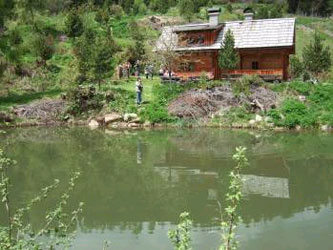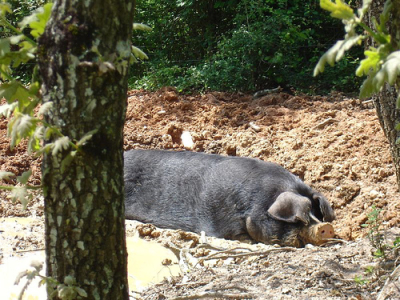
How to gley a pond
 Has anyone ever tried gleying
a pond? Gleying seems to be an old Russian method that mimics the
way ponds sometimes form in nature. The goal is to produce an
anaerobic layer in the soil underneath the pond, which somehow prevents
water from percolating through (perhaps due to slime on the anaerobic
bacteria.) Here are tips for gleying a pond, compiled from
various websites (none of which feels very definitive):
Has anyone ever tried gleying
a pond? Gleying seems to be an old Russian method that mimics the
way ponds sometimes form in nature. The goal is to produce an
anaerobic layer in the soil underneath the pond, which somehow prevents
water from percolating through (perhaps due to slime on the anaerobic
bacteria.) Here are tips for gleying a pond, compiled from
various websites (none of which feels very definitive):
Create
a six to nine inch layer of fresh compostables. Some sites recommend
using a layer of animal manure covered by a second layer of high carbon
waste material such as paper or cardboard. Other sites note that
grass clippings can be used in place of the manure, and still others
leave out the high carbon layer.
Get
your compostables wet, then seal out the air. Most people recommend
adding a layer of soil on top and tamping it down, but others mention
putting plastic over the pond to keep air out completely. Still
other sources seem to consider the cardboard layer to be the one that
seals air out.
Wait
two to three weeks.
During this time, you shouldn't allow your gley to dry up, but you
can't fill the pond yet. After the wait, your pond is supposed to
be permanently sealed...or sealed for a couple of years (depending on
who you talk to.)
 I'm a bit leery of the
technique because I can't find anyone who mentions that they have tried
it personally, although second and third hand reports abound. I'm
also curious to know whether anaerobic pond muck from the alligator
swamp would provide instant gley. If I hauled out a few
bucketsful and used the muck to line a little indentation in our forest
garden, would we have a mini pond? Or is the anaerobic layer
something that forms in place and can get disrupted by digging?
Clearly, gleying a small pond is going to have to be added to my
post-growing season experiments list!
I'm a bit leery of the
technique because I can't find anyone who mentions that they have tried
it personally, although second and third hand reports abound. I'm
also curious to know whether anaerobic pond muck from the alligator
swamp would provide instant gley. If I hauled out a few
bucketsful and used the muck to line a little indentation in our forest
garden, would we have a mini pond? Or is the anaerobic layer
something that forms in place and can get disrupted by digging?
Clearly, gleying a small pond is going to have to be added to my
post-growing season experiments list!
(As a side note, I
couldn't find a single picture on the internet of gleying a pond.
The closest ones were these photos of Sepp Holzer's pig method of
sealing a pond. As usual, click on the image to view the source
website.)
Want more in-depth information? Browse through our books.
Or explore more posts by date or by subject.
About us: Anna Hess and Mark Hamilton spent over a decade living self-sufficiently in the mountains of Virginia before moving north to start over from scratch in the foothills of Ohio. They've experimented with permaculture, no-till gardening, trailersteading, home-based microbusinesses and much more, writing about their adventures in both blogs and books.
Want to be notified when new comments are posted on this page? Click on the RSS button after you add a comment to subscribe to the comment feed, or simply check the box beside "email replies to me" while writing your comment.

Nowadays (in the Netherlands), ponds in sandy soil are usually built using a waterproof foil liner. Before those were available ponds were usually lined with several inches of blue-gray clay, which creates an impermeable layer.
I'd imagine the gleying method is a way of creating such a layer of clay.
Of course if the water table is high enough, all you have to do is dig a hole and watch it fill up.
Yeah, liners are the common practice around here too. But they're quite expensive!
I think the gleying process waterproofs differently from clay. It would create a layer of organic matter, which is very different from a layer of clay. Clay works as a liner just because it drains very slowly, but the organic matter is supposed to form some sort of hydrophobic layer. Unfortunately, I can't seem to find anything definitive about it on the internet!!
On the other hand, as I think back over your comment, the term gley is also used by soil scientists to refer to waterlogged, anaerobic soils that have turned blue-gray. So maybe I'm wrong and your blue-gray clay is the same as gleying?
It seems that clay mostly consists of fine grained minerals. Contrary to what I thought, organics do not seem to be a large part of clay.
You might also find the article on gley soil informative.
Technically, when you talk about clay, you're not talking about organic matter at all. (Of course, clay soil will probably have a bit of silt, sand, and organic matter too.) Clay, silt, and sand are all mineral particles of varying sizes, while organic matter is completely different.
The gley soil article was the one that made me think that maybe the gray clay you were talking about could be showing the same sort of biological action as what people mean when they say "gleying a pond."
From what I understand, Holzer's "pig method" (which he mimics on a larger scale using backhoe buckets) vibrates saturated soil under pressure (i.e. a submerged bucket provides the weight). This causes compaction of the soil and a separation of fine silt (bottom) and larger particles (and rocks) which propagate to the surface (look up the brazil nut effect).
This effectively seals a pond in almost any soil type. I suspect organics are used where only light/large (e.g. sandy) soil exists.
He based the method on observation of pigs wallowing in mud.
This tickles a few things in my mind, although no sure answers. Old earthen plasters often used manure mixed with clay as part of the finish/top coats. The manure often either had hair or partially digested grasses/straw that would act as a strengthener or re-inforcer but the water-resistant properties were from the mix of clay and manure.
I grew up next to a swamp. It was a potato field in the dust bowl. In the 80's it was anywhere from 5-15 feet deep over quite a few acres. Very flat, no drop offs. The "muck" at the bottom was black organic material over clay. It formed naturally over time (aka drain tile from nearby farms and a fair amount of manure run-off). The black muck was almost soft and frilly and gelatin-like at the top and as you would sink into it.. it would get more and more solid but never solid enough you'd stop sinking till you hit the clay. It was a foot to two feet deep. The swamp didn't really have fish, it had leeches, squitoes, algae of many various types, lots and lots of fascinating water walking bugs, birds and beaver and bald eagles.... And yes, I spent an inordinate amount of my childhood in and around that swamp staring at various bugs and birds and algae and ... and.. and...
No fish as it pretty much froze solid and most fish would freeze out.
I have no idea if this description helps but it held water by golly, by gosh...
c, I wonder if the swamp you grew up next to was already low enough that it was holding water because of the groundwater level? That's why our alligator swamp holds water, I'm pretty sure.
I spent a lot of time as a kid playing in wild wet areas too. Nothing more fun!
Hello Anna, Thanks for the chicken waterers a few years back, the first one I installed is still working a treat! What a surprise to see that it was your site I got to about glaying.
I heard about glay and glaying ponds from Bill Mollisons PC material and have at last got around to attempting it... A few years back I made a 'tyre pond' for watercress lined with PVC plastic (what most people use as liners here in Spain). Having learned how bad it is and seen the success of the water cress I wanted to grow more aquatic plants. Last summer I made a double tier tyre pond. That is a lorry/truck tyre totally below ground level and a car tyre in the centre below that.
Yesterday I filled it with green weeds and covered it with plastic (drat I forgot to take a picture before putting on the plastic). I hope it will seal well, and my partner is very happy it will only take 2-3 weeks until I remove the plastic.
Di you have a go yet? How did it turn out? Did you try using the stuff from the aligator pond?
I haven't used the organic slime technique yet, but I've made a number of small unlined ponds on a terraced mountainside using an approach closer to Sepp Holzer's, though without the help of machinery. I'm lucky in having fairly clay-rich soils which are not too hard to get to hold water provided you don't hit bedrock, which is rarely very far from the surface on these slopes. The biggest battle I have is with voles and moles. When the ponds are immature, the rodents are forever breaching them with their burrows and draining them out through their runs ... usually through a terrace wall. Not good. But over time the breaches get less frequent as various layers build up in the soil to warn them they're approaching a body of water - I'm guessing no rodent in its right mind is going to want to burrow into a wall of water under pressure ...
The ponds are part of a system of swales which are kept permanently full of water and fed by a small mountain stream and some springs. The amount of water moving through them is fairly small - it doesn't make any noticeable difference to the volume of water in the stream - but it's enough to keep the ponds full while hydrating the surrounding growing areas and has completely transformed these terraces in our hot dry summers. I worried at first that the whole thing was on too small a scale to really work since small systems are much more sensitive to perturbation ... variations in flow and rodents ... but 4 years on it's all settling down nicely and as each year goes by I take it out a bit further to extent my growing areas.
I do have one pond that's problematic - it's too close to ancient underground drainage channels running on top of the bedrock and the water keeps finding a route into the channels. I may try sliming this one, as well as enlisting the help of some ducks.
Wendy --- Thanks for sharing your experiences! I went and checked out your site and love the photos and notes on your experiences. Adding you to my reading list now....
Our experiences with unlined ponds have been good too, although our area is so wet that water stands just about everywhere. Your experiences in a much drier climate definitely show that the idea has merit!